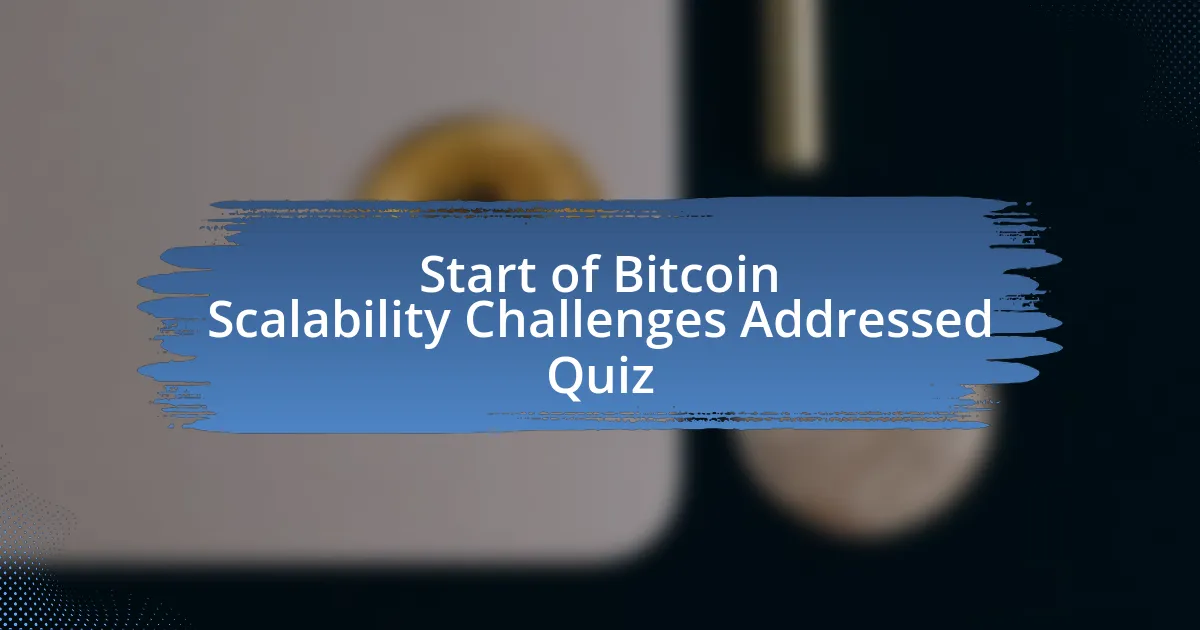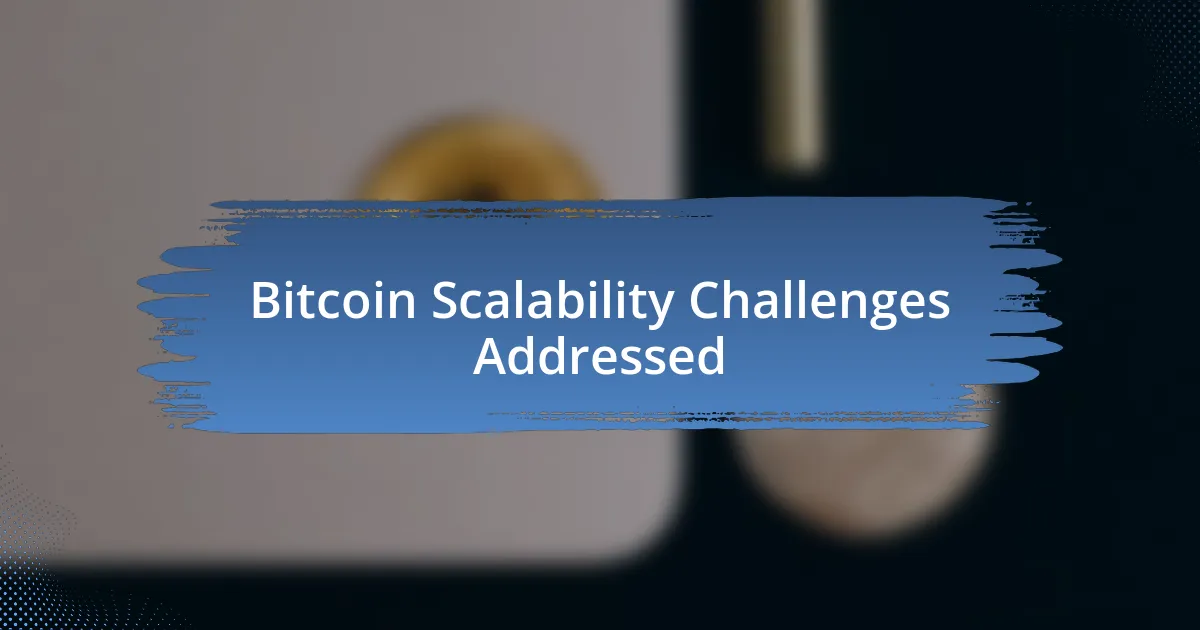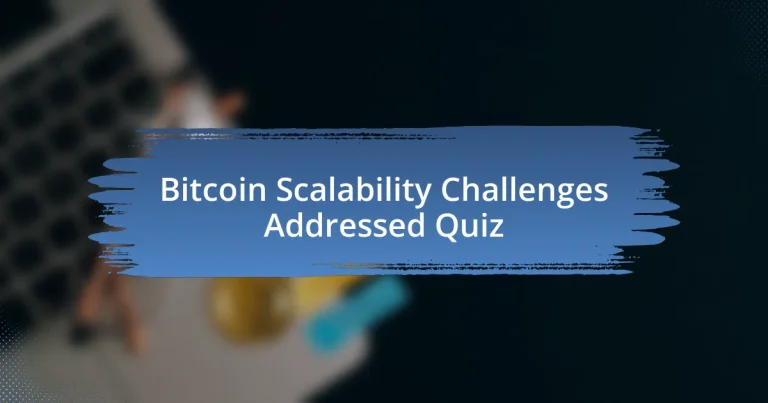
Start of Bitcoin Scalability Challenges Addressed Quiz
1. What is the primary issue with Bitcoin`s scalability?
- Limited on-chain transaction throughput
- High transaction fees
- Incomplete node synchronization
- Low mining rewards
2. How many on-chain transactions can the Bitcoin network handle per second?
- 7 to 10
- 50 to 100
- 1 to 2
- 20 to 25
3. What is the average block time for the Bitcoin blockchain?
- 10 minutes
- 15 minutes
- 30 minutes
- 5 minutes
4. How often is the block time adjusted in the Bitcoin network?
- Every two weeks
- Every week
- Every month
- Every year
5. What is the maximum size of each block in the Bitcoin blockchain?
- 1 MB
- 8 MB
- 2 MB
- Approximately 4 MB
6. What is the name of the 2017 soft fork that changed the block size limit?
- BlockSize
- ChainSplit
- HardFork
- SegWit
7. Why are on-chain scaling solutions like increasing the block size considered risky?
- Increasing block size enhances decentralization benefits.
- Larger blocks improve transaction speeds without risks.
- Block size increases reduce miner incentives globally.
- On-chain scaling solutions can compromise network security.
8. What is the primary goal of layer 2 solutions in addressing Bitcoin`s scalability issues?
- Enable Bitcoin users to transact off-chain.
- Secure Bitcoin against attacks.
- Increase on-chain transaction limits.
- Simplify wallet management tasks.
9. How do layer 2 solutions help in reducing transaction costs and times?
- Layer 2 solutions help by ensuring all transactions are processed directly on the Bitcoin blockchain without any off-chain mechanisms.
- Layer 2 solutions work by increasing the block size on the Bitcoin blockchain to handle more transactions at once.
- Layer 2 solutions help in reducing transaction costs and times by processing transactions off-chain and then summarizing them as a single transaction on the Bitcoin blockchain.
- Layer 2 solutions reduce transaction costs and times by creating a secondary blockchain that functions independently of Bitcoin.
10. What is the name of the off-chain scaling solution developed to mitigate Bitcoin`s fees and long transaction times?
- Chainlink Node
- Lightning Network
- Ether Bridge
- Smart Chain
11. How does the Lightning Network facilitate transactions?
- The Lightning Network requires all transactions to be recorded on the main Bitcoin blockchain immediately.
- The Lightning Network waits for on-chain confirmations before processing any transactions.
- The Lightning Network limits the number of transactions to reduce congestion and fees.
- The Lightning Network facilitates transactions by allowing users to set up payment channels for instant, low-cost transfers.
12. What is the purpose of anchor transactions in the Lightning Network?
- Anchor transactions in the Lightning Network add information about the payment channel to the main blockchain.
- Anchor transactions in the Lightning Network are used to speed up block times.
- Anchor transactions in the Lightning Network serve as a wallet for storing cryptocurrencies.
- Anchor transactions in the Lightning Network are employed to increase the block size limit.
13. What are micropayments in the context of the Lightning Network?
- Micropayments in the Lightning Network are transactions that must always occur on-chain.
- Micropayments in the Lightning Network are large transactions requiring extensive verification.
- Micropayments in the Lightning Network are small transactions within payment channels.
- Micropayments in the Lightning Network are only for transactions involving physical goods.
14. How do payment channels in the Lightning Network reduce network fees?
- Payment channels require all transactions to be on-chain.
- Payment channels increase the number of miners needed.
- Payment channels only work with large transactions.
- Payment channels facilitate off-chain transactions.
15. What happens when a payment channel in the Lightning Network is closed?
- The final balance is sent to the main blockchain.
- The channel remains open indefinitely.
- The payment channel is permanently deleted.
- All funds are lost in the transaction.
16. What is the throughput of the Lightning Network?
- Nearly 250,000 transactions per second.
- About 100,000 transactions per second.
- Approximately 1 million transactions per second.
- Around 500,000 transactions per second.
17. How do sidechains help in solving Bitcoin`s scalability problem?
- Sidechains help by processing transactions faster off the main network.
- Sidechains do not affect transaction confirmation times at all.
- Sidechains primarily focus on on-chain transactions for better speed.
- Sidechains only increase the maximum block size allowed.
18. What are the common layer 2 scaling solutions for Bitcoin?
- Hard forks
- Block size increases
- Multi-signature wallets
- Sidechains
19. Why are sidechains considered effective in addressing scalability issues?
- Sidechains require all transactions to be on-chain, which slows processing.
- Sidechains only allow for the creation of new cryptocurrencies without benefits.
- Sidechains only increase the maximum block size but don`t solve latency.
- Sidechains help offload transactions from the main network, allowing for faster processing.
20. What is the primary goal of using sidechains in Bitcoin?
- Limit network usage
- Increase transaction fees
- Enhance mining rewards
- Improve transaction handling
21. How do rollups help in scaling Bitcoin?
- Rollups increase the block size, allowing more transactions per minute on the main blockchain.
- Rollups eliminate the need for miners, decentralizing transaction validation completely.
- Rollups create new cryptocurrencies that operate separately from Bitcoin for faster transactions.
- Rollups help in scaling Bitcoin by aggregating multiple transactions into a single transaction, reducing the load on the main network and increasing throughput.
22. What is the role of state channels in Bitcoin`s scalability solutions?
- State channels require all transactions to be processed on-chain.
- State channels enable continuous transactions without broadcasting each to the main network.
- State channels increase block size for higher throughput.
- State channels prevent off-chain transactions from occurring.
23. Why are state channels considered efficient?
- State channels increase transaction visibility on the main network.
- State channels only work during network congestion.
- State channels operate entirely on the main blockchain.
- State channels enable off-chain transactions to reduce fees.
24. What is the main advantage of using layer 2 solutions over on-chain solutions?
- They increase on-chain fees for users.
- They require more than one confirmation per transaction.
- They reduce the load on the main network.
- They eliminate the need for security measures entirely.
25. How do layer 2 solutions ensure the security and decentralization of Bitcoin?
- Layer 2 solutions rely solely on centralized servers to manage transactions and security.
- Layer 2 solutions eliminate the need for the main blockchain entirely, creating a shortcut for users.
- Layer 2 solutions increase the block size of the Bitcoin blockchain to handle more transactions.
- Layer 2 solutions anchor transactions to the main blockchain, ensuring security and transparency.
26. What is the impact of high demand for Bitcoin`s block space on transaction costs?
- High demand simplifies transactions, reducing overall costs for users.
- High demand decreases transaction costs as more users join the network.
- High demand leads to increased transaction costs due to network congestion.
- High demand has no effect on transaction costs at all.
27. How does the design of the Bitcoin blockchain limit its scalability?
- Each block can hold up to 1 million transactions at once.
- The design of the Bitcoin blockchain limits its scalability by producing a new block every 10 minutes.
- Blocks are generated every minute, allowing for faster processing.
- The Bitcoin blockchain can process unlimited transactions per second.
28. What is the relationship between block size and transaction processing time?
- Block size does not influence transaction processing time because all transactions are processed simultaneously.
- Larger block sizes have no effect on transaction processing time, as miners work at a consistent speed regardless of size.
- Larger block sizes can increase transaction processing time because miners need more time to solve the blocks, which slows down the network.
- Smaller block sizes decrease transaction processing time by enabling quicker mining tasks on the network.
29. How do larger block sizes affect node costs?
- Larger block sizes decrease node costs by reducing resource requirements.
- Larger block sizes have no effect on node costs or resource needs.
- Larger block sizes generate lower node costs through fewer transactions.
- Larger block sizes increase node costs because nodes need more resources.
30. What are the potential risks associated with increasing the block size?
- Improving transaction speed significantly.
- Lowering transaction fees across the board.
- Compromising security and decentralization.
- Reducing the block time to 5 minutes.

Quiz Successfully Completed!
Congratulations on completing the quiz on Bitcoin scalability challenges! We hope you found the questions engaging and thought-provoking. This quiz aimed to deepen your understanding of the complexities surrounding Bitcoin’s ability to scale effectively. Whether you’ve grasped the concepts of block size, transaction throughput, or the impact of layer two solutions, you are now better equipped to discuss these essential topics.
Throughout the quiz, you’ve likely uncovered how scalability issues can affect transaction times and fees in the Bitcoin network. You’ve also learned about proposed solutions, such as the Lightning Network and SegWit, that aim to alleviate these challenges. Understanding these concepts is crucial for anyone interested in the future of cryptocurrency. It builds a foundation for further exploration of blockchain technology.
To build upon what you’ve learned, we invite you to check out the next section on this page. It offers in-depth information about Bitcoin scalability challenges and the various solutions being explored today. This continuation will enhance your knowledge and provide a more comprehensive view of how Bitcoin can evolve to meet growing demands. Happy learning!

Bitcoin Scalability Challenges Addressed
Understanding Bitcoin Scalability
Bitcoin scalability refers to the network’s ability to handle an increasing number of transactions without compromising speed or efficiency. As more users engage with the Bitcoin network, the demand for processing transactions rises. This can lead to delays and higher fees, presenting a challenge to its practicality as a currency. For example, during peak times, the backlog can grow significantly, resulting in slower confirmation times.
Key Factors in Bitcoin Scalability Challenges
Several factors contribute to Bitcoin’s scalability issues, primarily block size, transaction throughput, and network latency. Block size limits the amount of data that can be processed in a single transaction block. Currently, Bitcoin’s block size is set at 1 MB, which restricts the number of transactions per second. Additionally, the time required to validate and confirm transactions adds to the congestion problem, affecting user experience.
Layer 2 Solutions for Improved Scalability
Layer 2 solutions aim to enhance Bitcoin’s scalability by allowing transactions to occur off the main blockchain. The Lightning Network is a prominent example. It enables users to create off-chain payment channels, allowing for instantaneous transactions with minimal fees. Once the payment channel closes, the net result is recorded on the Bitcoin blockchain. This method significantly increases transaction capacity while reducing load on the main network.
Soft Forks and Improvements in Protocols
Soft forks are backward-compatible updates that can improve Bitcoin scalability without disrupting the overall network. Segregated Witness (SegWit) is a notable soft fork that enhances transaction efficiency. By separating signature data from transaction data, SegWit increases the effective block size and therefore the number of transactions that can be processed. This helps alleviate pressure on the blockchain and reduces fees.
Future Directions for Bitcoin Scalability
The future of Bitcoin scalability may include further developments in Layer 2 solutions, improvements in blockchain technology, and ongoing research into sharding or other consensus mechanisms. As the demand on the network increases, continued innovation is crucial. The combination of technological advancements and community consensus will be essential in addressing scalability challenges effectively.
What are Bitcoin scalability challenges?
Bitcoin scalability challenges refer to the limitations in the Bitcoin network’s ability to process a large number of transactions quickly and efficiently. The primary issue is its block size, which is limited to 1 megabyte, restricting the number of transactions each block can hold to approximately 3,000 to 7,000. This can lead to network congestion, higher transaction fees, and slower confirmation times, especially during peak usage periods. According to data from blockchain explorers, during high demand, transaction fees have spiked, at times exceeding $60 per transaction.
How are Bitcoin scalability challenges being addressed?
Bitcoin scalability challenges are being addressed through various methods, including the implementation of the Lightning Network and Segregated Witness (SegWit). The Lightning Network allows off-chain transactions, significantly increasing transaction speed and reducing fees. SegWit optimizes block space by separating transaction signatures, allowing more transactions to fit within a single block. As of October 2023, SegWit adoption has reached over 50% among Bitcoin transactions, and the Lightning Network has processed millions of transactions, showcasing its efficacy in scalability enhancements.
Where are Bitcoin scalability challenges most evident?
Bitcoin scalability challenges are most evident during periods of high transaction volume, such as during market surges or significant news events. Notable instances occurred in December 2017 and May 2021, where transaction fees spiked extremely high, and confirmation times slowed considerably. Analytics from blockchain.com indicated transaction fees averaged around $55 in December 2017 due to network congestion. This illustrates the pressing need for effective scalability solutions.
When did Bitcoin scalability challenges first emerge?
Bitcoin scalability challenges first emerged shortly after Bitcoin’s inception in 2009, but they became more pronounced in 2017 during the price surge. The surge in popularity led to increased transaction demand, highlighting the limitations of the original network design. In 2017, the average block size reached near capacity during peak times. This trend prompted discussions and developments around improving Bitcoin’s scalability thereafter.
Who is involved in addressing Bitcoin scalability challenges?
Various stakeholders are involved in addressing Bitcoin scalability challenges, including developers, miners, and businesses. Developers contribute by creating and implementing technological solutions like SegWit and the Lightning Network. Miners, who validate transactions, play a crucial role as well, as their priorities impact network congestion and fees. Additionally, major companies in the cryptocurrency space, such as Blockstream and BitREFILL, are actively working on advancements to improve scalability. Their collaborative efforts are vital in shaping the scalability landscape of Bitcoin.


